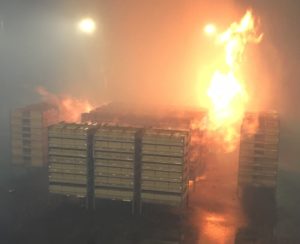What is Fire?
From the Harrington Group
 As fire protection engineers we spend a lot of time talking about how to prevent fires and mitigate their damage. Technology has come a long way over the years and the profession is constantly evolving, but let’s take a moment to go back to the basics.
As fire protection engineers we spend a lot of time talking about how to prevent fires and mitigate their damage. Technology has come a long way over the years and the profession is constantly evolving, but let’s take a moment to go back to the basics.
Let’s start at the very beginning: what is fire? It’s a rapid chemical reaction that requires fuel, heat, oxygen and an uninhibited chemical reaction—four components that make up what is known as the fire tetrahedron. A fire can be considered friendly (think cozy fireplaces, campfires, candles, cigarette lighters, gas stoves, etc.) or hostile (any unwanted fire that’s out of control and has limitless fuel and oxygen to feed on). And beyond that, a fire can be classified into one of five categories, according to the type of fuel that’s consumed and certain hazard characteristics. The three most common types of fire are as follows:
Class A: Fires that burn ordinary combustibles like wood, paper and cloth
Class B: Fires that burn combustible liquids like hydrocarbons, alcohols, and gases that support combustion
Class C: Fires involving energized electrical equipment (but if the energy source is disconnected, the fire typically becomes a Class A)
The other two classifications are a little less common:
Class D: Fires that involve combustible metals like potassium, sodium, aluminum and magnesium
Class K: Fires that involve cooking oils like animal and vegetable fats
As professionals in the field of fire protection, it’s our job to identify the potential hazards that exist in any given facility so we can effectively design a protection and mitigation scheme in case of fire. But even if you don’t have a degree in fire protection engineering, with the right knowledge and tools you can arm yourself as the first line of defense during the incipient fire stage. We’re talking, of course, about portable fire extinguishers. And just like fires, fire extinguishers can fall into one of five categories. There are several types of fire extinguishers, each serving a specific purpose.
Stay tuned for our next post about how to choose the right fire extinguisher.
Back to the Basics: What is Fire?
 As fire protection engineers we spend a lot of time talking about how to prevent fires and mitigate their damage. Technology has come a long way over the years and the profession is constantly evolving, but let’s take a moment to go back to the basics.
As fire protection engineers we spend a lot of time talking about how to prevent fires and mitigate their damage. Technology has come a long way over the years and the profession is constantly evolving, but let’s take a moment to go back to the basics.Let’s start at the very beginning: what is fire? It’s a rapid chemical reaction that requires fuel, heat, oxygen and an uninhibited chemical reaction—four components that make up what is known as the fire tetrahedron. A fire can be considered friendly (think cozy fireplaces, campfires, candles, cigarette lighters, gas stoves, etc.) or hostile (any unwanted fire that’s out of control and has limitless fuel and oxygen to feed on). And beyond that, a fire can be classified into one of five categories, according to the type of fuel that’s consumed and certain hazard characteristics. The three most common types of fire are as follows:
Class A: Fires that burn ordinary combustibles like wood, paper and cloth
Class B: Fires that burn combustible liquids like hydrocarbons, alcohols, and gases that support combustion
Class C: Fires involving energized electrical equipment (but if the energy source is disconnected, the fire typically becomes a Class A)
The other two classifications are a little less common:
Class D: Fires that involve combustible metals like potassium, sodium, aluminum and magnesium
Class K: Fires that involve cooking oils like animal and vegetable fats
As professionals in the field of fire protection, it’s our job to identify the potential hazards that exist in any given facility so we can effectively design a protection and mitigation scheme in case of fire. But even if you don’t have a degree in fire protection engineering, with the right knowledge and tools you can arm yourself as the first line of defense during the incipient fire stage. We’re talking, of course, about portable fire extinguishers. And just like fires, fire extinguishers can fall into one of five categories. There are several types of fire extinguishers, each serving a specific purpose.
Stay tuned for our next post about how to choose the right fire extinguisher.
Comments
Post a Comment